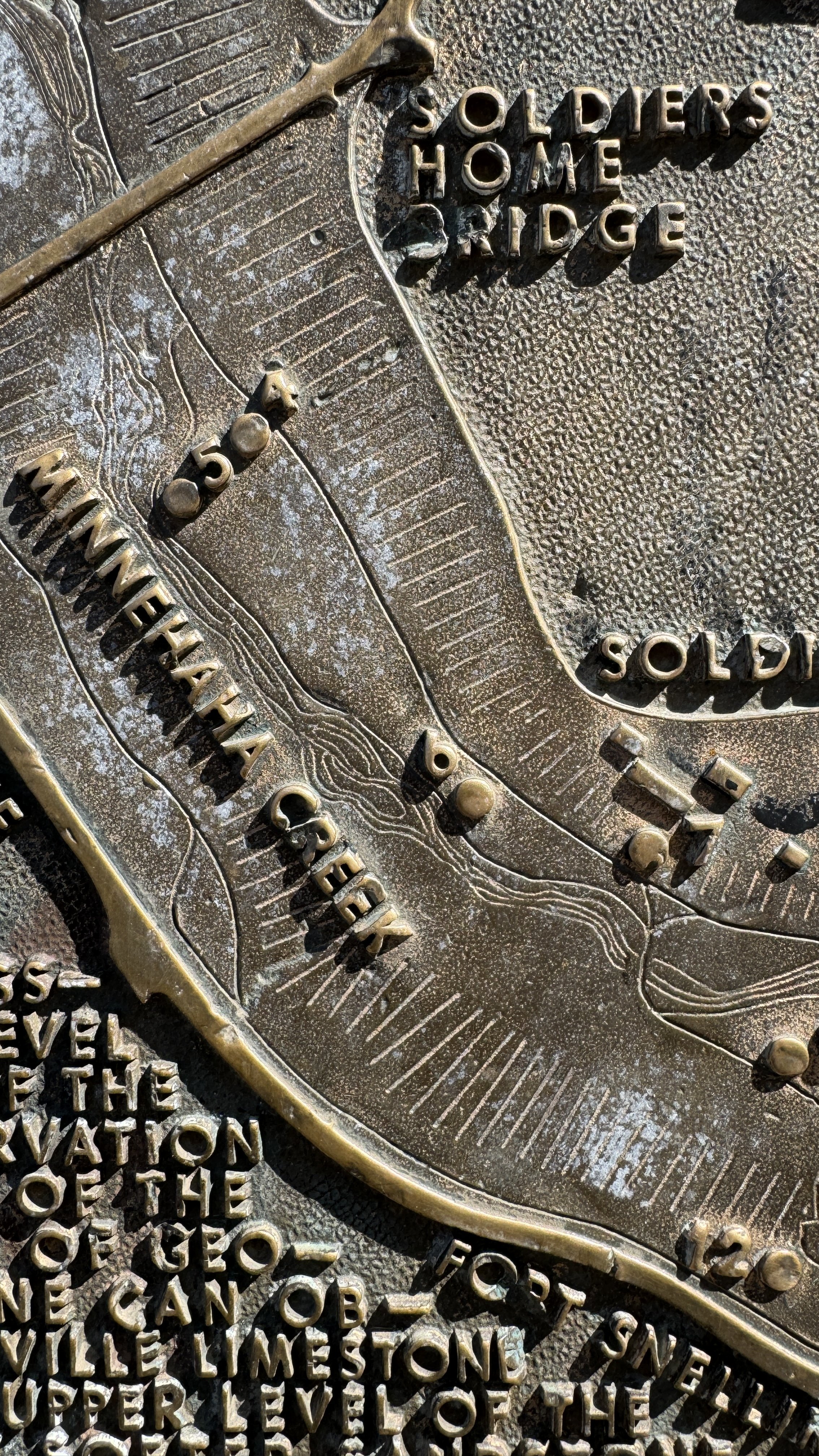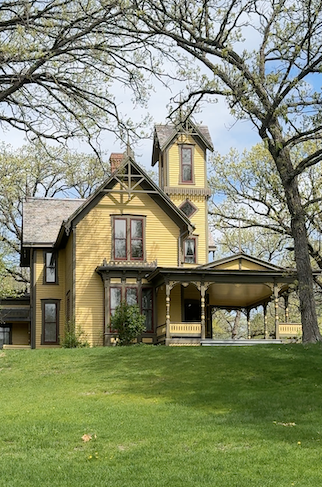The OTHER Minneapolis Mill District
Minnehaha Creek is so pretty and winds its way from Gray’s Bay on Lake Minnetonka all the way to the Mississippi River. Visiting the waterfall is high on everyone’s Minneapolis “must see” lists, but not many people know that before downtown Minneapolis became the Mill District, this creek also powered six different mills.
Where there is rushing water there is power. Harnessing that power for sawmills was necessary to build Fort Snelling and homes for the people who gathered around it. Grist mills, to grind wheat and corn into flour, were needed to keep all of them fed.
If we start where Minnehaha Creek empties into the Mississippi River and head west from there, the first mill ruins we would find would be those of the Godfrey Mill.
The Godfrey Mill
A man named Ard Godfrey saw the roaring water coming over the “Little Falls” (as Minnehaha Falls was called until Longfellow made them famous) and knew he could use it.
If the name Ard Godfrey already sounds familiar, it’s probably because you’ve heard of his house that still sits where it was moved in a park in Northeast Minneapolis. That house - the oldest surviving frame house in Minneapolis - was where Godfrey lived when he came to Minnesota from Maine in 1847. He was hired to build lumber mills at St. Anthony Falls.
Godfrey also built a sawmill on the creek in 1853, but nothing remains of it today because it burned down a decade later. Not much remains of the grist mill he built on the creek in 1857 either. You can find its location on the bronze map and see what remains of the stone dam he built to block the creek and control the waterpower. The mill building sat on the north side of the creek before it burned down in 1887.
The next mill up the Creek shared its name with the village it was in…but the land it was on is no longer in that village.
The Richfield Mill
Four miles upstream from Minnehaha Falls, hundreds of drivers, cyclists and walkers unknowingly cross over the remains of the dam that controlled Minnehaha Creek for the Richfield Mill. The slopes of the dam embankment have been rebuilt over and over as Lyndale Avenue South got more and more traffic and the bridge over the creek expanded.
When Philander Prescott built the first grist mill here in 1855, it and the area around it were called Richland. Just a couple years later, a town meeting in 1858 changed it to Richfield. The mill pond that gathered the creek’s water and supplied power for the mill was big - big enough to create a small lake about 20 feet deep that stretched almost all the way to Lake Harriet. But in 1887 Minneapolis expanded its southern boundary by annexing the land from 46th street to 54th and the Richfield Mill was no longer IN Richfield. The path of the creek was adjusted and the mill pond drained when the mill and dam were demolished and the first bridge built over it in 1892.
In a confusing twist, the Richfield Mill was bought by the Washburn Crosby Mills. This is why the nearby branch of the Hennepin County Library is named the Washburn Library and a mill stone (from their first mill downtown on the Mississippi River) is displayed outside on the corner.
The third mill “up the creek” also gave its name to the village it was in, but there’s still a lot more of it left to see.
The Edina Mill
If we keep following the creek two miles west of Lyndale Avenue South you’ll find another mill site that has left a lot more evidence of its history. The mill ruins lay inside of a park that honors the memory of Edina resident and soldier Dwight Williams. The park protects the archeological site where the Edina Mills once stood.
When the mill first opened in 1855, Edina didn’t exist yet. Just like lots of other mills, the Waterville Mill (named by the owner, William Hoyt) became the center of the community that grew up around it. The surrounding village also became known as Waterville. The Waterville Mill was sold to Jonathan Grimes in 1859 and then worked day and night to keep up with the demand at Fort Snelling during the Civil War. Grimes built his home nearby in 1869. His home and the street named after him are still there today. The Grimes descendants decided to sell the land in 1905. When they did, they divided it up and mapped out a new neighborhood called Morningside.
Andrew Craik, a Scottish immigrant, bought the Waterville Mill in 1869 and made some changes. The mill became the first in the state to make oatmeal and pearl barley. But more importantly, Craik changed the name. In honor of his hometown of Edinburgh and a poem written by the Scottish poet Robert Burns, Craik renamed it the Edina Mill.
In 1888, after Minneapolis annexed part of Richfield, there was a bit of a battle inside Grange Hall as what had been the western part of Richfield Township but was not annexed by Minneapolis tried to decide on a name as it became an independent village. Hennepin Park and Westfield were considered first, but after several meetings and some heated tempers, Edina barely squeaked out a majority of the vote.
The Edina mill was torn down in 1932 but you can still see the pilings it stood on, the dam that controlled its waterpower, the millstones and the mill pond.
Our 4th and 5th mills along the creek are both examples of how easily businesses that were once crucial can be completely wiped away.
The Globe Mill & The St. Alban’s Mill
These next two mills never really stood a chance. They were the last two to be built along Minnehaha Creek, but ultimately failed and even caused problems for the other mills.
The Globe Mill was built in 1874 in St. Louis Park and all evidence of it has been reabsorbed by the marsh around it. It was moderately successful and shipped grain as far away as Scotland, but it struggled all along until it was torn down in 1898.
St. Albans Mill was also built in 1874, but didn’t see any success. Not only was it struggling financially, but it was built in a bad spot. It’s dam, built to hold back the creek’s flow, was doing such a good job that it was backing up and flooding the next mill upstream. That mill finally had enough, but it out and tore it down in 1881. Today a condo development called St. Albans - and even has a little mill wheel - is in its place.
Although the Globe and St. Alban’s didn’t last long they still had an impact on the villages growing around them, but they were no competition for the sixth mill t on Minnehaha Creek.
Minnetonka Mills
The most western of the six mills built on Minnehaha Creek also grew to be the largest. It started out small in 1853, milling lumber for the building boom happening all throughout Minnesota. It even milled boards that were used in the first bridge over the Mississippi at Hennepin Avenue.
By 1868, it was turned into a grist mill and business took off. Within a decade they were grinding enough flour to ship stock to Boston, New York and abroad to Europe. They had 5 separate mill runs and two separate railroads had lines right up to the mill to transport grain and flour. Fifty-foot steamer boats came up the creek to deliver the mill’s mail.
Minnetonka Mills was a success, but it still couldn’t keep up with the massive output of the mills growing in Minneapolis’ Mill District. It finally shut down in 1886 and the mill building burned down on Christmas Day in 1902.
Today, you can see the remaining buildings in Minnetonka Mills Park. The management office has been turned into a garage. Only one of the 12 workers’ cottages still stands. The centerpiece of the park is the stunning Burwell House, home to Charles Burwell who was the mill manager.
All of these small mills have closed down in the name of efficiency and cost-effectiveness and Minnehaha Creek is gradually being restored along its natural path. Today, it is just a little creek with a whole lot of history.
A Special Thanks to the Minnesota Historical Society Archives of the Minnesota History magazine and the article “The Six Flouring Mills on Minnehaha Creek” by Foster W. Dunwiddie.







































